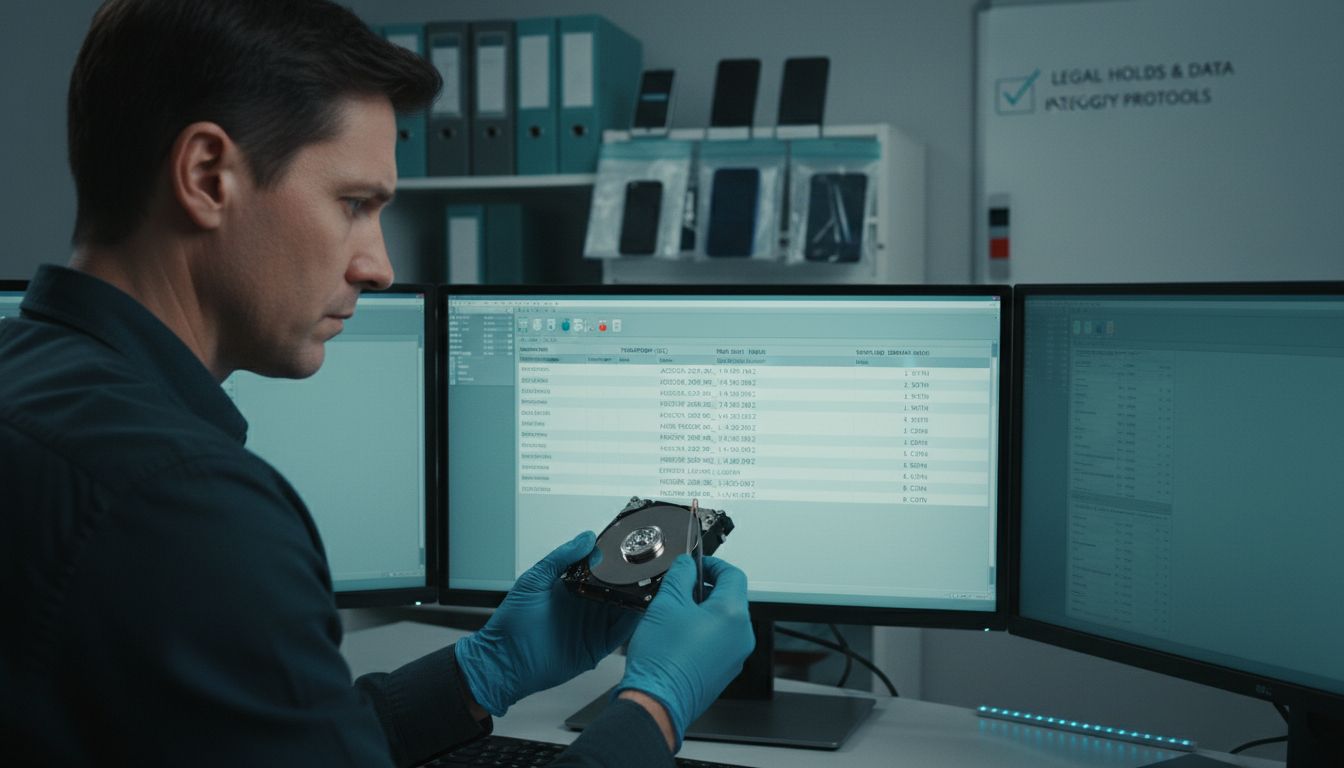Nearly 90 percent of legal cases today involve some form of electronic evidence, yet many professionals find navigating e-discovery is more complicated than expected. As digital information multiplies, understanding the principles behind e-discovery becomes essential for preventing costly mistakes in court. This guide offers clear insight into what e-discovery means, how it works, and why mastering its processes helps legal teams manage risk and build stronger cases.
Table of Contents
- Definition Of E-Discovery And Core Concepts
- Types Of E-Discovery And Digital Evidence
- E-Discovery Process Steps Explained
- Legal Requirements And Compliance Standards
- Risks, Costs, And Common E-Discovery Pitfalls
Key Takeaways
| Point | Details |
|---|---|
| Definition and Process of E-Discovery | E-discovery is a digital forensic process that transforms electronically stored information into admissible evidence, encompassing stages like identification, preservation, and analysis. |
| Types of Digital Evidence | Digital evidence includes emails, documents, multimedia files, and more, requiring strict adherence to authenticity and chain of custody for admissibility in legal proceedings. |
| Legal Compliance and Ethical Standards | Legal professionals must navigate complex requirements such as data privacy, spoliation prevention, and privilege protection to maintain the integrity of digital evidence. |
| Challenges in E-Discovery | Common pitfalls include data overload and inadequate preservation, emphasizing the need for robust digital forensics capabilities and strategic data management to mitigate risks and costs. |
Definition of E-Discovery and Core Concepts
Electronic discovery, or e-discovery, represents a sophisticated digital forensic process designed to locate, collect, and analyse electronically stored information (ESI) for legal proceedings. According to Cambridge Research, this process encompasses critical stages including data preservation, processing, review, and production.
At its core, e-discovery involves transforming digital data into legally admissible evidence. Law Research explains that this process covers a comprehensive range of digital formats, spanning:
- Emails and electronic communications
- Digital documents and spreadsheets
- Social media content
- Database records
- Cloud storage files
- Mobile device data
The primary objective of e-discovery is to extract, protect, and present electronic information that can substantiate or refute legal claims. Unlike traditional paper-based evidence discovery, digital forensics requires specialised technical expertise to navigate complex data environments while maintaining strict chain of custody protocols.
Legal professionals leverage e-discovery to investigate potential misconduct, resolve disputes, and gather critical evidence across various domains including corporate litigation, criminal investigations, intellectual property disputes, and regulatory compliance. By systematically processing digital information, organisations can uncover insights that might remain hidden in traditional investigative approaches.
Types of E-Discovery and Digital Evidence
Digital evidence encompasses a wide array of electronically stored information that can be critical in legal proceedings. Forensic Resources highlights that this evidence includes diverse digital artifacts that can provide crucial insights during investigations.
Key types of digital evidence include:
- Email Communications: Complete email threads, attachments, and metadata
- Communication Logs: Text messages, instant messaging histories, social media exchanges
- Document Files: Word processing documents, spreadsheets, PDFs
- Web Browser Histories: Browsing records, downloaded content, search histories
- System Logs: Computer access logs, network activity records
- Financial Records: Digital transaction logs, banking records
- Multimedia Files: Digital photographs, video recordings, audio files
The admissibility of digital evidence hinges on several critical factors. Forensic experts must demonstrate that the evidence is authentic, relevant, and unaltered during the collection and analysis process. This requires maintaining a strict chain of custody and employing forensically sound extraction techniques that preserve the original data’s integrity.
Explore our comprehensive guide on collecting digital evidence to understand the meticulous processes that ensure legal professionals can reliably use electronic information in court. Digital forensics professionals must navigate complex technical and legal landscapes, ensuring that every piece of digital evidence can withstand rigorous legal scrutiny.
E-Discovery Process Steps Explained
Electronic discovery follows a structured, methodical approach to managing digital evidence. According to EduBirdie Research, the e-discovery process encompasses several critical stages designed to ensure comprehensive and legally sound evidence collection.
The e-discovery workflow typically involves these key steps:
- Identification: Locating and mapping potentially relevant electronic data sources
- Preservation: Implementing legal holds to prevent data destruction or modification
- Collection: Extracting electronic information using forensically sound methods
- Processing: Filtering, organizing, and preparing data for detailed review
- Review: Examining collected data for relevance and potential privilege
- Analysis: Extracting meaningful insights and connecting digital evidence
- Production: Preparing and sharing admissible electronic evidence
- Presentation: Presenting digital evidence effectively during legal proceedings
Law Research emphasises that understanding these technical and legal nuances is crucial for legal professionals. Each stage requires meticulous attention to detail, ensuring that digital evidence maintains its integrity and authenticity throughout the investigative process.
Successful e-discovery demands a collaborative approach between digital forensics experts, legal teams, and IT professionals. By following a systematic methodology, organisations can transform complex digital information into clear, compelling evidence that withstands rigorous legal scrutiny.
Legal Requirements and Compliance Standards
Digital evidence carries significant legal implications that demand rigorous adherence to compliance standards. Forensic Resources emphasises that courts meticulously evaluate digital evidence based on critical factors such as relevance, authenticity, and procedural compliance.
Key legal considerations in e-discovery include:
- Warrant Requirements: Obtaining proper legal authorization for data collection
- Chain of Custody: Documenting every step of evidence handling
- Data Privacy Regulations: Protecting individual privacy rights
- Ethical Data Extraction: Ensuring non-invasive collection methods
- Spoliation Prevention: Maintaining evidence integrity
- Privilege Protection: Safeguarding confidential communications
Law Research highlights that legal professionals must navigate complex intersections between technical procedures and legal standards. This involves understanding intricate civil procedure rules, managing potential sanctions for improper evidence handling, and maintaining strict ethical guidelines throughout the digital forensics process.
Failure to comply with these standards can result in severe consequences, including evidence exclusion, legal penalties, and compromised case outcomes. Digital forensics experts must therefore maintain an unwavering commitment to legal and ethical protocols, treating each piece of electronic evidence with the highest level of professional scrutiny.
Risks, Costs, and Common E-Discovery Pitfalls
Electronic discovery presents a complex landscape fraught with potential challenges and financial implications. Cambridge Research highlights that organisations frequently encounter significant obstacles in managing digital evidence effectively.
Common e-discovery pitfalls include:
- Data Overload: Managing massive volumes of electronic information
- Incomplete Preservation: Failing to capture all relevant digital evidence
- Inadequate Metadata Handling: Overlooking crucial contextual information
- Inconsistent Collection Methods: Compromising evidence integrity
- Privilege Exposure: Accidentally revealing confidential communications
- Technical Complexity: Navigating intricate digital forensic processes
Law Research emphasises that these challenges can result in substantial financial and legal risks. The e-discovery process can become extraordinarily resource-intensive, with potential costs escalating quickly due to complex data analysis, expert consultations, and sophisticated forensic technologies.
Mitigating these risks requires a proactive, strategic approach. Legal teams must invest in robust digital forensics capabilities, develop comprehensive data management protocols, and maintain ongoing training to navigate the ever-evolving technological landscape. Ultimately, the cost of prevention is significantly lower than the potential penalties associated with e-discovery failures.
Master E-Discovery Challenges with Expert Digital Forensics Support
Navigating the complexities of e-discovery requires precision in preserving, collecting, and analysing electronic evidence while maintaining an unbroken chain of custody. If you find yourself overwhelmed by data volumes, uncertain about digital evidence authenticity, or concerned about legal compliance, our team is here to provide clarity and control. At Computer Forensics Lab, we specialise in managing every stage of the e-discovery process to help you transform vast digital information into reliable, court-ready evidence.
Discover how our ELectronic Evidence services ensure meticulous handling of digital data and how our Digital Evidence Preservation protocols maintain integrity across investigations. With proven expertise supporting legal professionals, law enforcement, and businesses, we provide not only forensic excellence but detailed reports you can trust from our Expert Witness specialists. Do not let complex e-discovery challenges jeopardise your case. Visit Computer Forensics Lab today to secure the digital advantage you need and begin your journey towards confident, compliant evidence handling.
Frequently Asked Questions
What is e-discovery?
Electronic discovery, or e-discovery, is a digital forensic process that involves locating, collecting, and analyzing electronically stored information (ESI) for legal purposes. It transforms digital data into legally admissible evidence for court.
What types of digital evidence are collected during e-discovery?
Digital evidence can include emails, communication logs, document files, web browser histories, system logs, financial records, and multimedia files, all of which can be crucial in legal proceedings.
What are the key steps in the e-discovery process?
The e-discovery process typically involves identification, preservation, collection, processing, review, analysis, production, and presentation of digital evidence, ensuring comprehensive and legally sound evidence collection.
What are the legal requirements for e-discovery?
Legal requirements for e-discovery include obtaining proper warrants for data collection, maintaining a chain of custody for evidence, adhering to data privacy regulations, and ensuring ethical data extraction methods.


